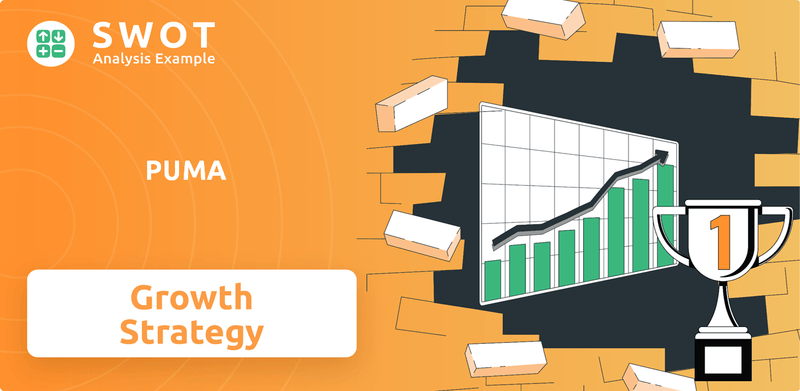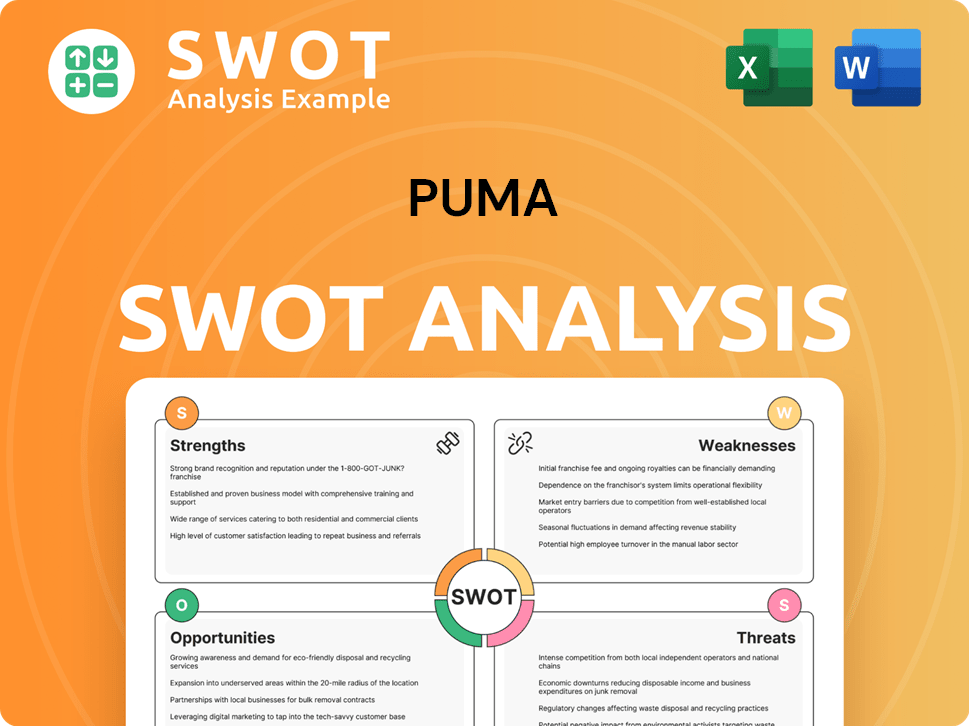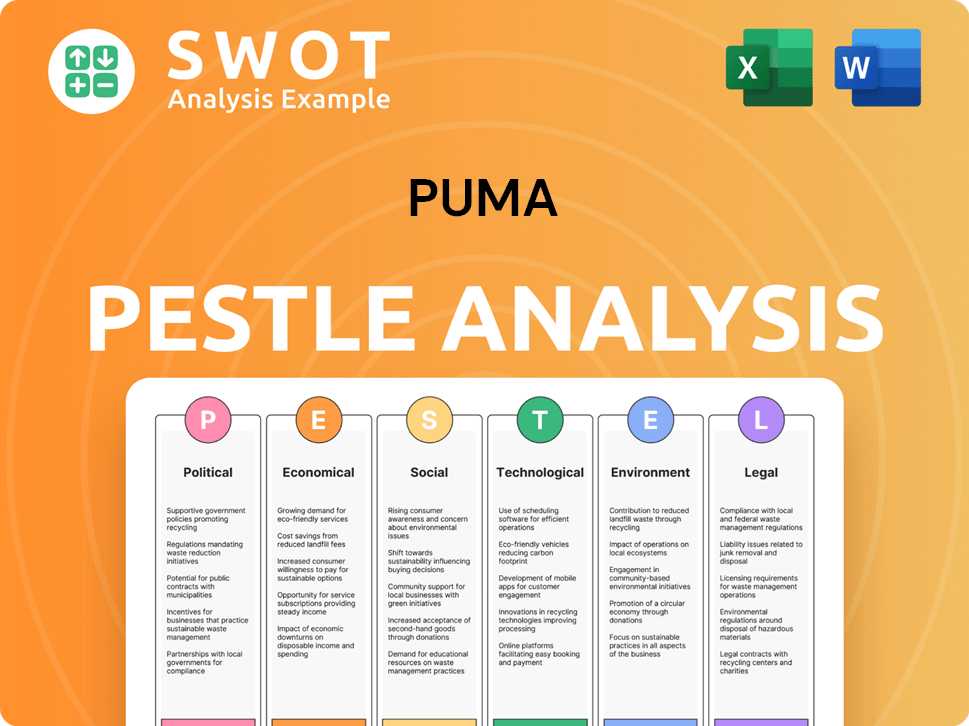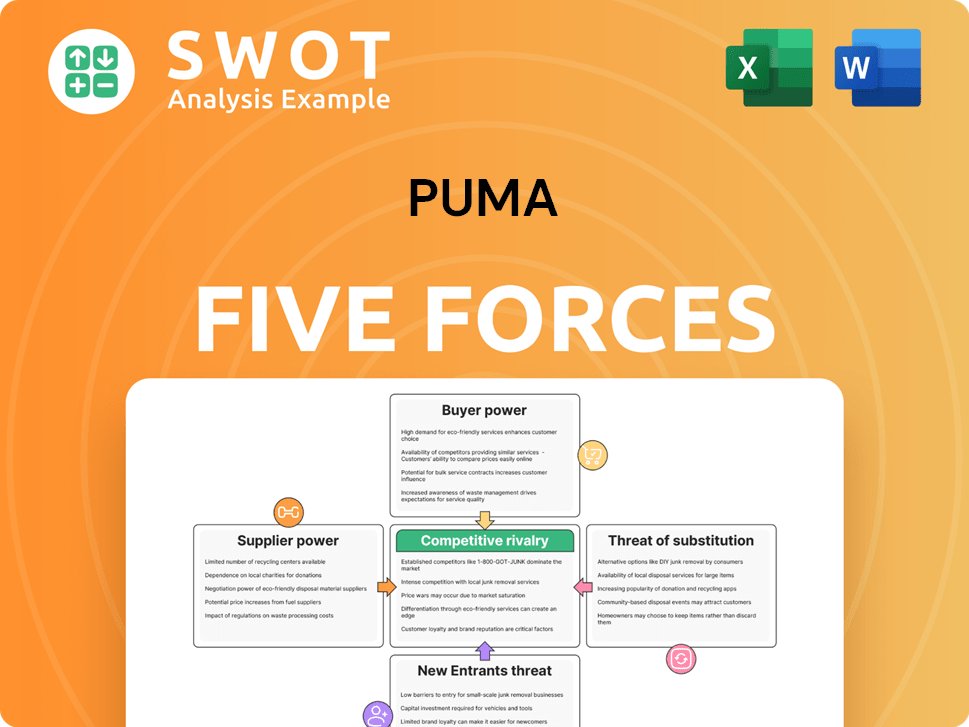PUMA Bundle
Can PUMA Maintain Its Momentum?
PUMA, a global powerhouse in athletic wear, has consistently demonstrated the power of a well-defined growth strategy. Founded in 1948, the company has evolved from a small German enterprise into a leading global sports brand. Its journey showcases the importance of strategic planning and adaptation in the competitive sports industry.

This PUMA SWOT Analysis will explore PUMA's ambitious plans for the future, including its expansion plans in Asia and its commitment to product innovation and trends. By analyzing PUMA's growth strategy, we can assess its potential for continued success in the global market. Understanding PUMA's financial performance review and its strategic partnerships is crucial for investors and analysts alike, providing insights into the company's long-term growth strategy within the dynamic competitive landscape.
How Is PUMA Expanding Its Reach?
The company is aggressively pursuing expansion initiatives to boost its global market share and diversify its revenue streams. A primary focus of the PUMA growth strategy is international expansion, particularly in emerging markets. This strategy involves targeted marketing campaigns, increased retail presence, and strategic partnerships with local distributors. The aim is to capitalize on the significant growth potential in these regions for sports and lifestyle products.
The company is also investing heavily in its direct-to-consumer (DTC) channels, including e-commerce platforms and owned retail stores, to enhance brand experience and improve profitability. This includes expanding its e-commerce capabilities in various regions to meet the growing demand for online shopping. The company's strategic approach is designed to not only reach new customers but also to stay ahead of industry changes and ensure sustained relevance in the competitive sports apparel and footwear market.
In terms of product categories, PUMA continues to innovate and expand its offerings beyond its traditional strengths in football and running. The company has made significant strides in basketball, motorsports, and golf, signing prominent athletes and launching performance-driven products to capture new consumer segments. These initiatives are designed to reach new customers and ensure sustained relevance in the competitive sports apparel and footwear market.
PUMA is focused on expanding its presence in key regions, especially in emerging markets, to increase its PUMA market share. This includes targeted marketing efforts and strategic partnerships. The company aims to strengthen its position through increased retail presence and collaborations with local distributors.
The company is investing in DTC channels, including e-commerce platforms and owned retail stores. This strategy enhances the brand experience and improves profitability. The expansion of e-commerce capabilities in various regions is crucial to meet the growing demand for online shopping.
PUMA is expanding its product offerings beyond traditional categories like football and running. The company is making significant strides in basketball, motorsports, and golf. This diversification helps capture new consumer segments and drive revenue growth.
The company is actively seeking strategic partnerships to enhance its market position. Collaborations with prominent athletes and brands are a key part of this strategy. These partnerships help to reach new audiences and strengthen brand appeal.
The company's expansion plans are also supported by a robust digital transformation strategy. PUMA is enhancing its e-commerce capabilities and leveraging digital marketing to improve customer engagement. For example, in 2024, PUMA reported strong e-commerce growth, reflecting the success of its digital initiatives. The company is also exploring new business models, such as subscription services and personalized product offerings, to foster deeper customer engagement and loyalty. Furthermore, PUMA remains open to strategic mergers and acquisitions that align with its long-term growth objectives and could provide access to new technologies, markets, or talent. For more insights, you can read about the Marketing Strategy of PUMA.
The company’s focus on international expansion, particularly in emerging markets, is a cornerstone of its growth strategy. Investing in DTC channels and expanding e-commerce capabilities are critical for enhancing brand experience and profitability. Product diversification and strategic partnerships further support the company’s growth objectives.
- International Expansion: Focus on emerging markets with targeted marketing and partnerships.
- DTC Channels: Investment in e-commerce and owned retail stores.
- Product Innovation: Expanding beyond traditional categories like football and running.
- Strategic Partnerships: Collaborations with athletes and brands.
PUMA SWOT Analysis
- Complete SWOT Breakdown
- Fully Customizable
- Editable in Excel & Word
- Professional Formatting
- Investor-Ready Format

How Does PUMA Invest in Innovation?
The PUMA growth strategy is heavily reliant on innovation and technology. The company consistently invests in research and development (R&D) to stay ahead in the competitive sports and lifestyle market. This commitment is evident in its product development and digital transformation initiatives, which are crucial for its PUMA future prospects.
PUMA's approach to technology and innovation includes both internal development and external collaborations. The company works with startups, academic institutions, and other innovators to bring new ideas to life. This strategy helps PUMA adapt to changing consumer preferences and maintain a strong PUMA brand performance.
PUMA's innovation strategy is also focused on sustainability. The company is actively developing products using more sustainable materials and production methods. This focus is important for reducing its environmental impact and meeting the increasing demand for eco-friendly products. For a broader view of the PUMA competitive landscape, consider exploring the Competitors Landscape of PUMA.
PUMA is actively integrating technology across its value chain. This includes design, manufacturing, supply chain management, and retail. The use of data analytics and AI helps the company understand consumer preferences and optimize product development.
PUMA focuses on creating cutting-edge products that enhance athletic performance and consumer experience. New platforms and technical capabilities, such as advanced material science for footwear and smart apparel, are key. These innovations contribute to PUMA's growth objectives by offering differentiated products.
PUMA is committed to sustainability, developing products with eco-friendly materials and processes. Initiatives like 're-PUMA' address textile waste and explore circularity. This focus is critical for long-term growth and aligning with consumer values.
PUMA invests significantly in R&D to create innovative products. This includes in-house development and collaborations with external partners. Ongoing investments in innovation ensure PUMA remains at the forefront of sports technology.
PUMA collaborates with external innovators, including startups and academic institutions. These partnerships help PUMA access new technologies and ideas. Collaborations are a key part of PUMA's innovation strategy and drive product development.
PUMA continues to enhance its e-commerce capabilities to reach a wider audience. This includes improving online shopping experiences and expanding its digital presence. A strong e-commerce strategy is vital for driving PUMA's revenue growth forecast.
PUMA's innovation strategy encompasses several key areas, driving PUMA's PUMA market share and brand performance. These advancements are critical for maintaining a competitive edge and meeting evolving consumer demands.
- Material Science: Developing lighter, more durable materials for footwear and apparel, enhancing performance and comfort.
- Smart Apparel: Integrating sensors into apparel to track athletic performance and provide data-driven insights.
- Data Analytics: Utilizing data analytics and AI to understand consumer preferences, optimize product development, and personalize marketing efforts.
- Sustainable Production: Implementing eco-friendly manufacturing processes and using sustainable materials to reduce environmental impact.
- Circular Economy: Initiatives like 're-PUMA' focus on textile waste reduction and circularity in product design and lifecycle.
PUMA PESTLE Analysis
- Covers All 6 PESTLE Categories
- No Research Needed – Save Hours of Work
- Built by Experts, Trusted by Consultants
- Instant Download, Ready to Use
- 100% Editable, Fully Customizable

What Is PUMA’s Growth Forecast?
The financial outlook for the company is centered on its ambitious growth strategy, aiming for sustained revenue increases and healthy profit margins. For 2024, the company anticipates currency-adjusted sales growth in the mid-single-digit percentage range. This positive trajectory is supported by ongoing investments in marketing, product innovation, and direct-to-consumer channels.
The company projects an operating result (EBIT) between €620 million and €700 million for 2024. This forecast indicates a focus on improving profitability through operational efficiencies and a favorable sales mix, prioritizing higher-margin products and regions. The company's financial health is further bolstered by a strong balance sheet and a disciplined approach to capital allocation.
Historically, the company has shown resilience in its financial performance, even during challenging global economic conditions. Analyst forecasts generally align with the company's positive outlook, recognizing the brand's strong momentum and effective strategic execution. The financial strategy highlights sustainable growth, driven by market expansion and product innovation, while maintaining a focus on profitability and shareholder value. To understand the company's origins, you can read a Brief History of PUMA.
The PUMA growth strategy focuses on expanding market share and enhancing brand performance. This includes strategic investments in key areas such as product innovation, marketing, and digital channels. The company aims to capitalize on emerging market opportunities while maintaining a strong presence in established markets.
The PUMA financial performance review indicates a commitment to sustainable growth and profitability. The company's financial targets for 2024 reflect its confidence in its strategic initiatives. Key performance indicators (KPIs) include revenue growth, operating profit, and earnings per share (EPS).
The PUMA revenue growth forecast for 2024 projects a mid-single-digit percentage increase in currency-adjusted sales. This forecast is underpinned by the company's investments in product innovation and expansion into new markets. The company's e-commerce strategy is also a key driver of revenue growth.
PUMA market share is influenced by its brand performance and competitive landscape. The company's strategic initiatives aim to increase its market share in key regions. The competitive landscape includes major players in the sportswear industry, with PUMA focusing on differentiation through product innovation and brand positioning.
The company’s financial health is reflected in several key metrics.
- Revenue Growth: Mid-single-digit percentage growth expected for 2024.
- Operating Result (EBIT): Projected between €620 million and €700 million for 2024.
- Strategic Investments: Ongoing investments in marketing, product innovation, and direct-to-consumer channels.
- Profitability Focus: Emphasis on operational efficiencies and higher-margin products to improve profitability.
PUMA Business Model Canvas
- Complete 9-Block Business Model Canvas
- Effortlessly Communicate Your Business Strategy
- Investor-Ready BMC Format
- 100% Editable and Customizable
- Clear and Structured Layout

What Risks Could Slow PUMA’s Growth?
The growth trajectory of the global sports and lifestyle industry presents several potential risks and obstacles for companies like the one under analysis. These challenges range from intense competition to supply chain vulnerabilities and the need for continuous technological adaptation. Effective risk management and strategic agility are crucial for navigating these complexities and ensuring sustained growth in the dynamic market.
Intense competition from established and emerging brands requires constant innovation and effective brand differentiation. Changes in regulations, particularly regarding international trade, labor laws, and environmental standards, can impact operations. Supply chain disruptions, geopolitical tensions, and raw material sourcing issues can also affect production and delivery.
Technological advancements, such as the evolution of e-commerce and new manufacturing processes, demand continuous adaptation and investment. Internal resource constraints, including talent acquisition and retention, can also hinder growth initiatives. The company's ability to address these risks through a comprehensive framework is critical for future success.
The sports and lifestyle market is highly competitive, with major players like Nike and Adidas holding significant market share. The company must continually innovate and differentiate its brand to maintain a competitive edge. Competitive pressures can impact Owners & Shareholders of PUMA by affecting profitability and market share.
Supply chain disruptions, including geopolitical tensions and natural disasters, can affect production and timely product delivery. The company relies on a global supply chain, making it susceptible to disruptions. Diversifying the supply chain and implementing robust risk management strategies are essential to mitigate these risks.
Changes in international trade, labor laws, and environmental standards can impact operations. These regulations can increase costs or limit operational flexibility. Staying compliant with evolving regulations is crucial to avoid penalties and maintain a positive brand image.
The rapid evolution of e-commerce and new manufacturing processes necessitates continuous adaptation and investment. The company must invest in digital transformation and new technologies to remain competitive. Failure to adapt can lead to a loss of market share and reduced profitability.
Talent acquisition and retention are critical for driving growth initiatives. Attracting and retaining skilled employees can be challenging in a competitive market. Investing in employee development and creating a positive work environment are crucial for mitigating this risk.
Consumer preferences are constantly evolving, with a growing focus on sustainability and ethical sourcing. The company must adapt its product offerings and marketing strategies to meet changing consumer demands. Ignoring these trends can lead to a loss of market share and damage brand reputation.
The company employs a comprehensive risk management framework, including supply chain diversification and scenario planning. Cybersecurity measures protect digital assets. The company's ability to adapt during the COVID-19 pandemic by accelerating digital transformation and optimizing inventory management demonstrates its resilience.
Increasing focus on sustainability and ethical sourcing is shaping the company's future. The company must prioritize sustainable practices to meet consumer expectations. This includes using eco-friendly materials and ensuring fair labor practices throughout its supply chain to maintain its brand performance.
PUMA Porter's Five Forces Analysis
- Covers All 5 Competitive Forces in Detail
- Structured for Consultants, Students, and Founders
- 100% Editable in Microsoft Word & Excel
- Instant Digital Download – Use Immediately
- Compatible with Mac & PC – Fully Unlocked

Related Blogs
- What are Mission Vision & Core Values of PUMA Company?
- What is Competitive Landscape of PUMA Company?
- How Does PUMA Company Work?
- What is Sales and Marketing Strategy of PUMA Company?
- What is Brief History of PUMA Company?
- Who Owns PUMA Company?
- What is Customer Demographics and Target Market of PUMA Company?
Disclaimer
All information, articles, and product details provided on this website are for general informational and educational purposes only. We do not claim any ownership over, nor do we intend to infringe upon, any trademarks, copyrights, logos, brand names, or other intellectual property mentioned or depicted on this site. Such intellectual property remains the property of its respective owners, and any references here are made solely for identification or informational purposes, without implying any affiliation, endorsement, or partnership.
We make no representations or warranties, express or implied, regarding the accuracy, completeness, or suitability of any content or products presented. Nothing on this website should be construed as legal, tax, investment, financial, medical, or other professional advice. In addition, no part of this site—including articles or product references—constitutes a solicitation, recommendation, endorsement, advertisement, or offer to buy or sell any securities, franchises, or other financial instruments, particularly in jurisdictions where such activity would be unlawful.
All content is of a general nature and may not address the specific circumstances of any individual or entity. It is not a substitute for professional advice or services. Any actions you take based on the information provided here are strictly at your own risk. You accept full responsibility for any decisions or outcomes arising from your use of this website and agree to release us from any liability in connection with your use of, or reliance upon, the content or products found herein.